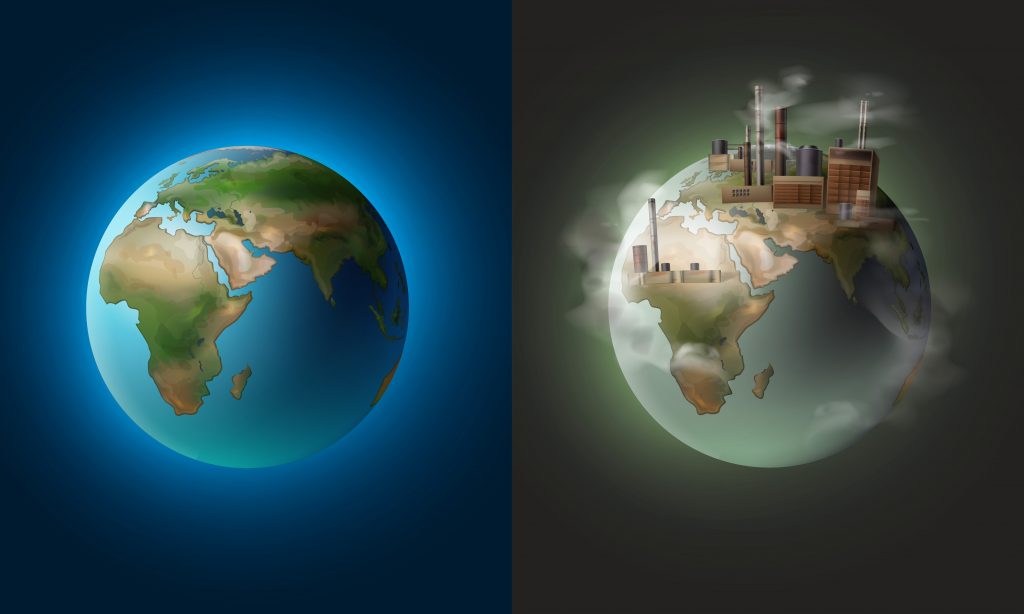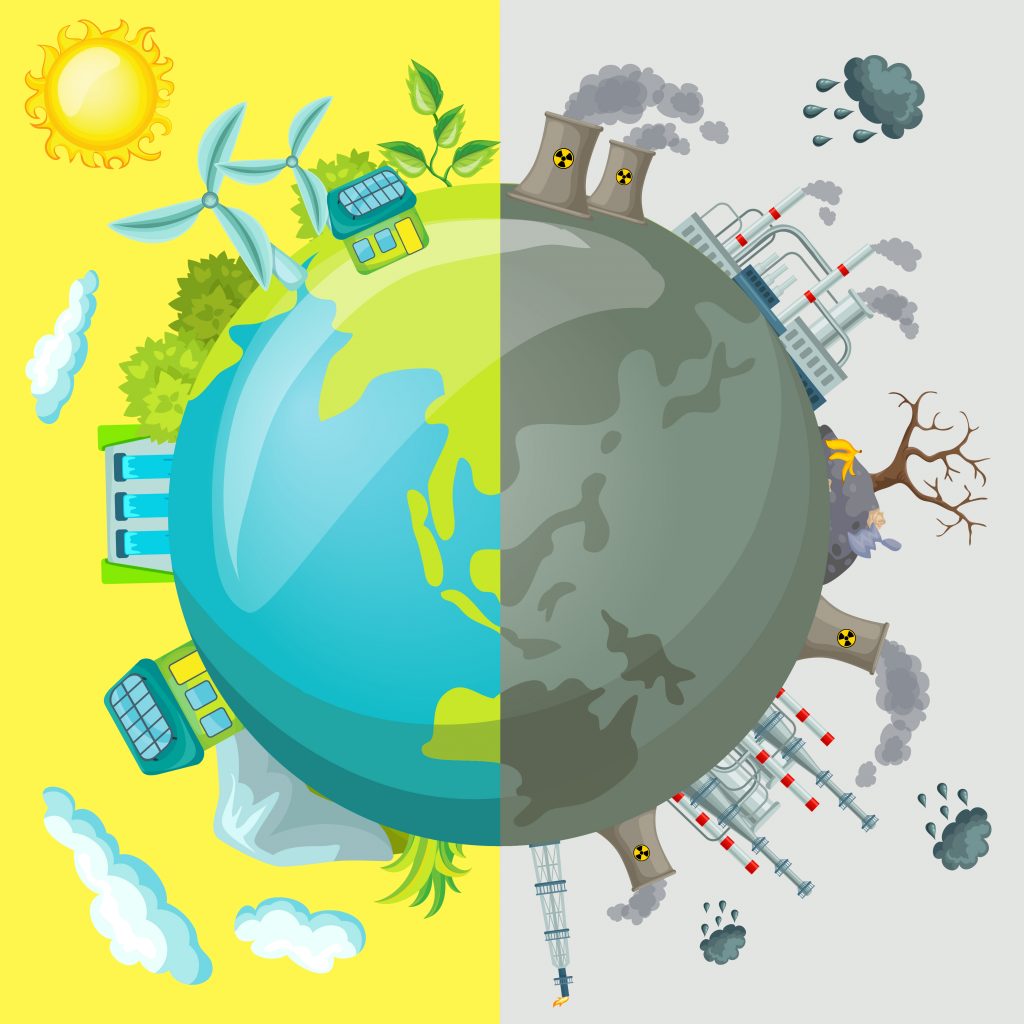
Is Pollution a Problem?
When pollutants are introduced into the natural environment and cause harm, this is referred to as pollution. Pollutants are chemicals or energies that are either foreign or naturally occurring that contribute to pollution.
Both natural and man-made (anthropogenic) sources pollute the air. Human-made pollutants, on the other hand, are becoming increasingly relevant in the global air pollution equation due to combustion, construction, mining, agriculture, and warfare.
Some common sources of pollution: –
- One of the most significant sources of air pollution is motor vehicle exhaust. In terms of air pollution emissions, China, the United States, Russia, India, Mexico, and Japan dominate the world.
- The most significant stationary pollution sources include chemical plants, coal-fired power plants, oil refineries, petrochemical plants, nuclear waste disposal activity, incinerators, large livestock farms (dairy cows, pigs, poultry, etc.).
- Heavy industry includes PVC manufacturers, metals factories, plastics factories, and other heavy industries.
- Agricultural air pollution is caused by modern agricultural methods such as clear felling and burning of natural plants, as well as pesticide and herbicide spraying.
- Heavy metals (such as chromium, cadmium – found in rechargeable batteries, and lead – found in lead paint, aviation fuel, and even gasoline in some countries) chlorinated hydrocarbons (CFH), MTBE, zinc, arsenic, and benzene are some of the most common soil contaminants.
- Ordinary municipal landfills are a source of many chemical substances entering the soil environment, originating from the wide variety of waste accepted, particularly illegally discarded substances, or from pre – 1970 landfills that may have been subject to little control in the United States or the European Union.
- There have also been some uncommon discharges of polychlorinated dibenzodioxins, such as TCDD, which are often referred to as dioxins.
- The motor vehicle is the most common cause of noise pollution, accounting for over 90% of all undesirable noise globally.
Pollution: A global issue
Pollution of the environment is a worldwide issue that is intrinsically related to rapid industrialisation and urbanisation. It harms the environment’s long-term viability and ecosystem services. Before moving on to the theme topic, we’ll go through a quick overview of environmental contamination (also known as pollution science.
Environmental pollution is the undesirable transformation of our environment as a result of man’s actions, either directly or indirectly, through changes in the energy pattern, radiation levels, chemical and physical constitution, and abundance of species.
It is a global issue that affects both developed and developing countries, and it draws people’s attention because of its serious long-term implications.

- Loss of vegetation
- Biological diversity
- Excessive concentrations of dangerous chemicals in the ambient atmosphere and food grains.
- Rising risks of environmental accidents and dangers to life support systems all point to a reduction in environmental quality as a result of pollution.
Pollution is viewed differently by different people, but it is widely agreed that it is the result of the urban-industrial and technological revolutions, as well as the rapacious and rapid exploitation of natural resources, increased rates of matter and energy exchange, and ever-increasing industrial wastes, urban effluents, and consumer goods.
It is a barrier to the profitable extraction of coal reserves. The standards for environmental protection in developed countries are stricter than in underdeveloped countries. As a result, obtaining a license to open mines entails time-consuming procedures that generate delays.
In addition, Indian authorities have begun to impose strict environmental pollution regulations. As a result, environmental problems can be completely avoided, although such solutions are expensive.
Crops, animals, forests, and bodies of water are all harmed by air pollution. It also adds to the ozone layer’s depletion, which protects the Earth from the sun’s ultraviolet rays. Acid rain is another detrimental result of air pollution, which destroys plants, soils, waterways, and wildlife.
Effects of pollution:
Have we ever taken a second to think about how the pollution of a single-vehicle affects the surrounding area? There are so many of their effects of pollution and some aren’t even discovered yet.
- Many creatures, including humans, are susceptible to poor air quality. Respiratory sickness, cardiovascular disease, throat irritation, chest pain, and congestion can all be caused by ozone pollution.
- Water pollution kills about 14,000 people every day, largely as a result of untreated sewage contaminating drinking water in developing countries.
- An estimated 500 million Indians do not have access to a proper toilet, according to estimates.
- In 2013, over ten million individuals in India became ill as a result of waterborne infections, with 1,535 people dying, the majority of them being children.
- Almost 500 million Chinese people do not have access to clean drinking water. According to a 2010 study, China’s air pollution causes 1.2 million premature deaths per year.
The excessive amounts of smog that China has been experiencing for a long time can harm residents’ bodies and cause various ailments. In 2007, the World Health Organization projected that air pollution kills half a million Indians per year. According to studies, the number of individuals killed in the United States each year could be above 50,000.
- Skin irritations and rashes can result from oil spills.
- Hearing loss, high blood pressure, stress, and sleep disruption are all caused by noise pollution.
- Mercury has been related to neurologic symptoms and developmental delays in children.
- The elderly are particularly vulnerable to ailments brought on by air pollution. Those who have heart or lung problems are at a higher risk. Children and infants are also in grave danger.
- Lead, as well as other heavy metals, has been linked to neurological issues. Chemical and radioactive chemicals have the potential to cause cancer and birth abnormalities.
According to a study published in October 2017 by the Lancet Commission on Pollution and Health, global pollution, specifically toxic air, water, soils, and workplaces, kills nine million people each year, more than AIDS, tuberculosis, and malaria combined, and 15 times more than wars and other forms of human violence.
“Pollution is one of the major existential issues of the Anthropocene period,” according to the study’s conclusions. Pollution jeopardises the stability of the Earth’s support systems and puts human societies at risk of extinction.”
Differences:
Climate change is a huge threat to our planet’s health. Although pollution and climate change are inextricably related, they are frequently considered as different issues. The greenhouse effect is exacerbated by rising CO2 and other air-polluting gases, which elevates temperatures and impacts global weather patterns.
While climate change and pollution are not the same things, they do share many similarities and synergies.
- A blanket of pollution traps heat around the world, causing global warming, commonly known as climate change.
- Cars, factories, residences, and power plants that burn fossil fuels such as oil, coal, natural gas, and gasoline contribute to this pollution.
- Pollution from global warming knows no bounds.
- Pollution of the environment occurs when pollutants are introduced into the natural environment, resulting in negative consequences.
Even though they appear to be two separate issues, climate change and pollution are inextricably linked, therefore lowering pollution also protects the climate.
Although air pollutants comprise more than just greenhouse gases—most notably carbon dioxide, but also methane, nitrous oxide, and others—there is a significant overlap: the two frequently interact.
For example, diesel engine pollution in the form of particulate matter travels around the world, eventually settling in the most remote locations, including the polar regions.
Pollution Standards:
ThePollutant Standards Measure, or PSI, is a type of air quality index that employs a numerical value to describe the number of pollutants in the atmosphere.
Both issues stem from the same source: the existing energy model. The combustion of fuel exacerbates both climate change and pollution by increasing CO2 emissions, which contribute to global warming. Other pollutants like nitrogen oxides (NO and NO2), sulphur oxides (SO2 and SO3), and particulate matter, on the other hand, are the main contributors to air pollution.
PSI was originally based on five air pollutants, but it has since 1 April 2014 incorporated fine particulate matter (PM2.5).
For their regions, many countries have their own Ambient Air Quality Standards. In the United States, the Clean Air Act mandates that the Environmental Protection Agency (EPA) establish National Ambient Air Quality Standards (NAAQS).
The Clean Air Act distinguishes between two types of ambient air quality standards:
- Primary standards safeguard the public’s health, including the health of “vulnerable” groups such as asthmatics, children, and the elderly.
- Secondary requirements safeguard the public’s welfare, including protection from reduced visibility.
Before November 2009, India established Air Quality Standards on April 11, 1994, which were then amended on October 14, 1998. The 2009 guidelines decreased the maximum allowed limits for pollutants even further and made them uniform across the country.
Previously, industrial zones were subjected to less strict regulations than residential neighbourhoods. In addition, in October 2014, a new National Air Quality Index (AQI) was established to provide information on air quality in an easily understandable format to the general public.
PM10, PM2.5, NO2, SO2, CO, O3, NH3, and Pb are the eight pollutants for which short-term (up to 24-hourly averaging period) National Ambient Air Quality Standards are set, and the worst reading in these pollutants reflects the AQI for that city.
Annual average PM2.5 concentrations should not exceed 5 g/m3, and 24-hour average exposures should not exceed 15 g/m3 more than 3 – 4 days per year, according to the new guidelines.
Interim targets have been set to aid in the planning of incremental milestones toward cleaner air, especially for cities, regions, and countries with high levels of it. The annual mean for PM2.5 is 35 g/m3, while the 24-hour mean is 75 g/m3.
- Annual mean of 25 g/m3, 24-hour mean of 50 g/m3.
- Annual mean of 15 g/m3, 24-hour mean of 37.5 g/m3.
- Annual mean of 10 g/m3, 24-hour mean of 25 g/m3.
For the remaining major pollutants, the new suggested guideline values are:
- PM10 concentrations of 15 g/m3 yearly mean, 45 g/m3 24-hour mean (particulate matter having a diameter of 10 microns or smaller).
Pollution Guidelines:
The WHO Air Quality Guidelines: Global Update 2021 provide an assessment of the health consequences of air pollution as well as pollution levels that are detrimental to human health.
- In 2019, 99 percent of the world’s population lived in areas where air quality standards set by the WHO were not reached.
- In 2016, it was projected that ambient (outside air pollution) caused 4.2 million premature deaths worldwide, in both cities and rural areas.
- Low- and middle-income countries accounted for 91 per cent of the premature deaths, with the WHO South-East Asia and Western Pacific areas accounting for the majority.
- Cleaner transportation, energy-efficient houses, electricity generation, industry, and better municipal waste management policies and investments will minimise the main sources of outdoor air pollution.
- Indoor smoke, in addition to outside air pollution, is a severe health danger for the 2.6 billion people who use biomass, kerosene, and coal to cook and heat their houses.
The Central Pollution Control Board (CPCB) has set permissible noise limits for several places in India. The allowed level of noise in different zones for both day and night has been determined by noise pollution standards.
- The allowed limit in industrial zones is 75 dB during the day and 70 dB at night.
- During the day and night, it is 65 dB and 55 dB in commercial zones, and 55 dB and 45 dB in residential areas, respectively.
In addition, state governments have established “quiet zones,” which are defined as locations within 100 metres of schools, colleges, hospitals, and courts. The maximum allowable noise level in this zone is 50 decibels during the day and 40 decibels at night.

- Previously, the Air (Prevention and Control of Pollution) Act of 1981 addressed noise pollution and its sources.
- However, under the Noise Pollution (Regulation and Control) Rules, 2000, they are now governed independently.
- The Environment (Protection) Rules, 1986 also set noise limitations for automobiles, air conditioners, refrigerators, diesel generators, and certain types of construction equipment.
Water quality guidelines are quantitative concentrations or narrative assertions based on scientific evidence that is advised to protect various water usage. Among these are:
- Agriculture (livestock watering and irrigation), recreation, and beauty are all aspects of aquatic life.
- The Alberta Surface Waters Environmental Quality Guidelines include guidelines for:
- water quality on the surface (to protect aquatic life, agricultural and recreational uses).
- tissue residue of good quality sediment (to protect wildlife consumers and fish from direct toxicity).

Greate article. Keep writing such kind of information on your site.
Im really impressed by your site.
Hey there, You’ve done an excellent job.
I’ll definitely digg it and for my part recommend to my friends.
I am sure they’ll be benefited from this web site.
Thank you so much for your enthusiastic feedback and for recommending our site to your friends! It’s incredibly rewarding to hear that you find the articles valuable and that you’re impressed by the content we provide. Your support in sharing our site helps us reach and assist more people, which is always our primary goal.
We’re committed to continuing to deliver high-quality, informative content, so stay tuned for more updates. If there are any specific topics or areas you or your friends are particularly interested in, please feel free to let us know. We always appreciate suggestions from our readers. Thanks again for your kind words and for being a part of our community! 🌟📚🙌
Greate post. Keep writing such kind of info on your site. Im really impressed by your site.
Hey there, You have performed a fantastic job. I will certainly digg it and in my view suggest to my friends. I’m confident they’ll be benefited from this site.
Thank you so much for your kind words and encouragement! I’m glad to know that you’re impressed with the content on our site. It’s always rewarding to know that our efforts are appreciated and making a positive impact. Your support in sharing the site with your friends means a lot, and I hope they find it just as beneficial. Stay tuned for more posts, and if there are any specific topics you’d like to see covered, feel free to suggest them. Your feedback is invaluable in helping us continue to improve and provide valuable content. Thanks again for being a part of our community! 🌟🌍